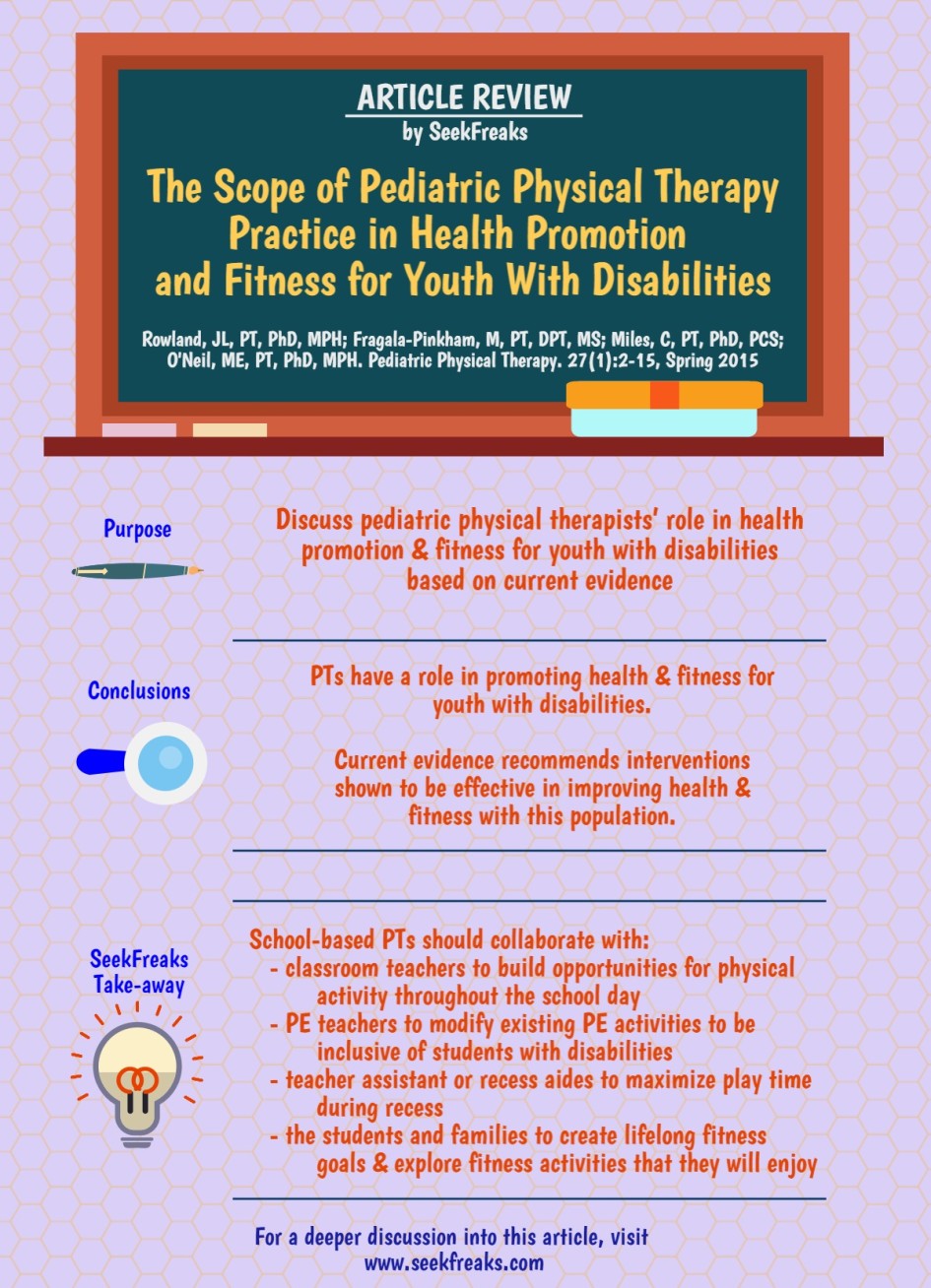[smbtoolbar]
Many of our students with disabilities will one day become adults with disabilities. How much physical activities do the students with disabilities you work with currently engage in? What is their commitment to lifelong fitness goals?
Rowland et al would like this article to serve as a “call to action” for PTs to include fitness strategies into their interventions.
- They describe techniques that PTs may employ during the following Stages of Change: Precontemplation, Contemplation, Preparation, Action and Maintenance.
- They recommend the use of fitness measures such as functional strength tests (e.g., sit-to-stand), functional aerobic capacity tests (e.g., shuttle run) and skill-based fitness measures (e.g., pediatric balance scale) to gather the student’s baseline and monitor progress.
- They suggest building the tolerance of children with disabilities (starting with 20 minutes a day) so that they can perform the recommended 60 minutes of moderate to vigorous physical activity each day that includes the following: aerobic, strengthening and bone-strengthening exercises. An additional suggestion is the use of 10-15-minute bouts throughout the day (though noted as not a formal recommendation). Specific exercise programs for different diagnoses that are based on studies are included in the article and can also be found by clicking here to find the APTA Section on Pediatrics Fact Sheet of the same title.
How can we promote fitness in school based practice? How can we build the opportunities for up to 60 minutes of physical activities each day? Using our typical once a week, twice a week or once a month 30-minute sessions of PT for fitness activities would fall very short of this goal. However, we can utilize our sessions to collaborate with teachers and other school staff (who are more often in contact with the students) to build opportunities and capacity for physical activities throughout the school week.
As movement and health experts in our schools, we can work closely with the physical education teachers to ensure that students with disabilities are included in all PE activities. We can help design student-specific exercise programs or, better yet, modify existing PE activities (e.g., different size balls, adapted equipment, altering rules or tasks) so that students with disabilities can play and exercise with their peers and benefit socially, as well. We can work with teachers, paraprofessionals (aka teacher assistant) and recess aides to maximize student play time during recess. They should be trained on specific alternative games that may be played in the playground and movement activities that may be conducted indoors in case of indoor recess. We can collaborate with teachers to develop structured movement activities throughout the day that would not just promote fitness but also attention and alertness. For teachers that are not confident enough in their skills to lead movement breaks, there are also exercise videos available online (e.g.,GoNoodle, youtube movement videos) or on DVDs that we can recommend.
As early as possible and throughout the students’ time at school, we should discuss with them lifelong fitness goals. We should help them explore and decide on fitness activities that they are interested in. We can collaborate with their parents/guardians and connect them with community resources that can provide and support these activities. It is also important that these discussions be included in the student’s individualized transition plan.
~~~~~~~~~~ 0 ~~~~~~~~~~
Freakishly Fast Poll
Seeking Your Views
What are the specific ways that you have incorporated physical activities into the school routines? Are there movement videos on YouTube or other online resources that you would recommend?
What have you found most effective in engaging teachers and other school personnel in addressing fitness for students with disabilities?
Do you have any specific suggestions for therapists working with students with moderate to severe physical impairment?
Leave your answers and comments below.
~~~~~~~~~~ 0 ~~~~~~~~~~
Readers of this article also read these:
Article Review: Physical Activity Improves Academic Performance
2 Tools to Promote Movement in the Classroom
Motoropoly 1: Motor Learning Principles in School – Instructions, Feedback & Demonstrations
Motoropoly 2: Motor Learning Principles in School – Task Specificity, Difficulty & Variability












2 Pingbacks